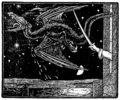Trusty John facts for kids
Quick facts for kids Trusty John |
|
|---|---|

The faithful servant stands beside his lord's bedside. An illustration of the story by H. J. Ford.
|
|
| Folk tale | |
| Name | Trusty John |
| Also known as | Faithful John, Faithful Johannes, John the True |
| Data | |
| Aarne–Thompson grouping | ATU 516 (Faithful John) |
| Region | Germany |
| Published in | Kinder- und Hausmärchen, by the Brothers Grimm |
| Related | In Love with a Statue, How to find out a True Friend, The Man of Stone, Amis et Amiles, Father Roquelaure, The Raven |
"Trusty John", also known as "Faithful John" or "John the True" (German: Der treue Johannes), is a famous German fairy tale. The well-known story was collected by the Brothers Grimm and published in their book Grimm's Fairy Tales in 1819. It is a tale about a very loyal servant who goes to great lengths to protect his king.
Contents
The Story of Trusty John
This fairy tale is about a servant named Trusty John. He is incredibly loyal to his king. When the old king is dying, he asks Trusty John to look after his son, the young prince. The old king gives John one special instruction: never let the prince see a certain room in the castle. This room holds a secret that could change the prince's life.
The Forbidden Portrait
After the old king passes away, the young prince becomes the new king. He is curious about the forbidden room. Even though Trusty John tries to stop him, the new king forces his way inside. There, he sees a beautiful portrait of a princess. The king falls instantly in love with her. He knows he must find her and make her his queen.
A Dangerous Journey
Trusty John helps the king plan a journey to find the princess. They prepare a ship filled with amazing treasures. They sail to the princess's country. The princess is very curious about the beautiful goods on the ship. She comes aboard to see them, and then the ship quickly sets sail, taking her away.
The Ravens' Warnings
While sailing back, Trusty John overhears three ravens talking. These ravens know the future. They speak of three dangers that will face the king and princess.
- The first raven says that when they reach shore, a horse will appear. If the king rides it, he will fly away and be lost forever. To save him, someone must kill the horse. But if that person tells anyone, their legs will turn to stone up to their knees.
- The second raven warns that at the wedding feast, poisoned wine will kill the king. To save him, someone must spill the wine. If that person tells anyone, they will turn to stone up to their waist.
- The third raven reveals that a dragon will attack the royal couple in their room. To save them, someone must drive off the dragon. If that person tells anyone, they will turn entirely to stone.
John's Sacrifice
Trusty John secretly prevents all three dangers. He kills the horse, spills the wine, and fights off the dragon. The king does not understand why John is doing these things. He trusts John for the first two actions. But when John fights the dragon, the king thinks John is harming the princess. The king decides to have Trusty John executed.
At the place of execution, Trusty John finally tells the king about the ravens' warnings. As he speaks, his body slowly turns to stone, just as the ravens predicted. The king realizes John's great loyalty and sacrifice. He is filled with sadness and regret.
A New Hope
Later, the queen gives birth to twin sons. The king learns that there is a way to bring Trusty John back to life. He must sacrifice his own children and rub John's stone statue with their blood. The king is heartbroken but decides to do it. He kills his sons and rubs their blood on the statue. Trusty John comes back to life!
Then, Trusty John performs the same act on the king's sons, bringing them back to life too. Everyone is overjoyed. Trusty John and the twin boys hide. The king then tells the queen what he did to bring John back, testing her loyalty. When the queen agrees that he did the right thing, John and the twins come out. Everyone embraces, and they all live happily ever after.
Origin of the Tale
The story of "Trusty John" was first published by the Brothers Grimm in the second edition of their book Kinder- und Hausmärchen in 1819. They heard the story from a German storyteller named Dorothea Viehmann. She lived in a village called Niederzwehren, near Kassel, Germany.
Adaptations
Comics
Trusty John appears as a supporting character in the long-running comic book series called Fables.
Images for kids



